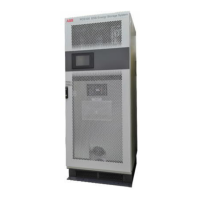3 Technical Specification
PCS100 ESS User Manual | 2UCD190000E001 rev. J 16
3.7 Service
MTTR 30 min typical by module exchange
Diagnostics Non-volatile event & service log
3.8 User Interface
User interface 8.4” color touch panel
Touch panel Full parameter control, system event log
Control inputs 10 digital inputs 24 Vdc (< 50ms)
- Start / Stop / Reset (Master Module)
- 7 programmable inputs
2 analog inputs on the extended I/O board
-10…+10 V / 4…20 mA, (< 2ms)
Resolution 0.1 %, Accuracy ± 2 %
2 PTC inputs
Control outputs 7 digital relay outputs, 250 V/1~, 30 Vdc (1 A)
- Running, warning, fault relays (Master Module)
- 4 programmable outputs on the extended I/O board
2 analog outputs on the extended I/O board
-10…+10 V / 4…20 mA (< 50ms)
Accuracy ± 2 %
Communication Ethernet
Modbus TCP/IP
RS485, Modbus RTU
3.9 Auxiliary Power
In case of rack systems two types of auxiliary power have to be provided from an external source
1
:
- 26.5 Vdc safety extra low voltage dc for control
- 230 Vac 50/60 Hz fan supply
It must be ensured that these external power supplies are suitable for industrial use and that cables are dimensioned appro-
priately. Attention should also be given to the grounding of the supplies: The 0Vdc of the 26.5 Vdc supply must be tied to
ground at one point and the 230 Vac fan supply should be configured as a TN (hard grounded) supply. Furthermore, it is not
recommended to connect other loads to the 26.5 Vdc supply or to interconnect +26.5 Vdc or 0 V lines when multiple sup-
plies are used in larger systems.
More detailed information about the dimensioning of the auxiliary supplies can be found in the application note
2UCD000420E003 “Auxiliary Power Supplies for PCS100 Rack Systems”.
Note:
1
In case of cabinet systems the control auxiliary power is provided by an internal 26.5 Vdc power supply located in
the Auxiliary Master Module and the only external supply is the 110 or 230 Vac 50/60 Hz as described in this sec-
tion. It is worth noting that on cabinet versions the Auxiliary Master Module is 230Vac 50/60Hz, but is always sup-
plied by an auxiliary “Z” transformer which allows customers to provide power either on 110Vac or 230Vac de-
pending on the connection of the primary windings of such auxiliary transformer.

